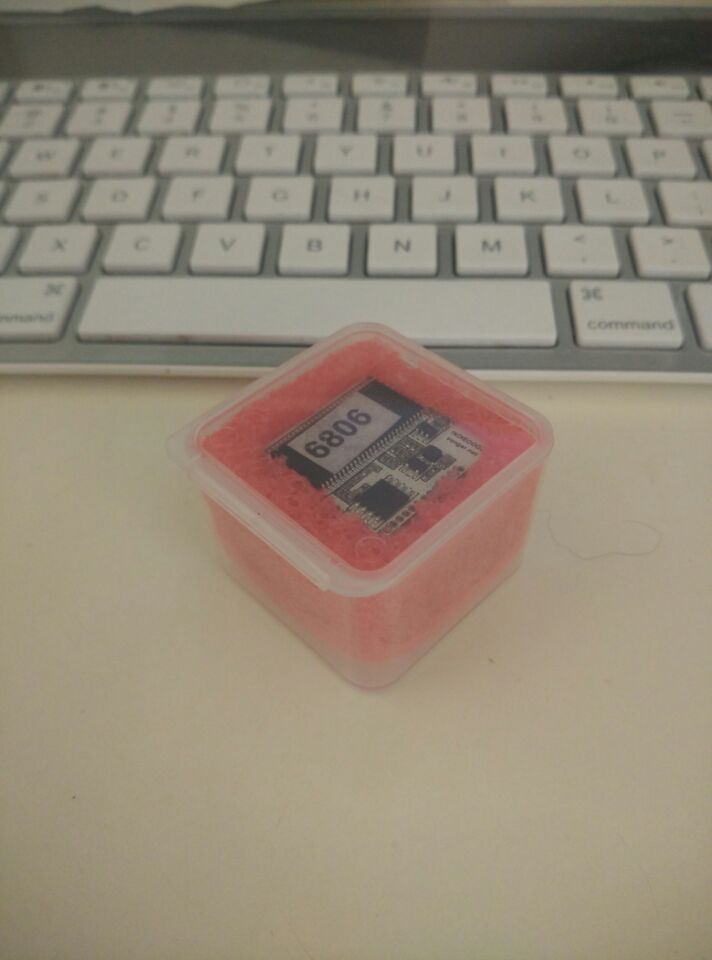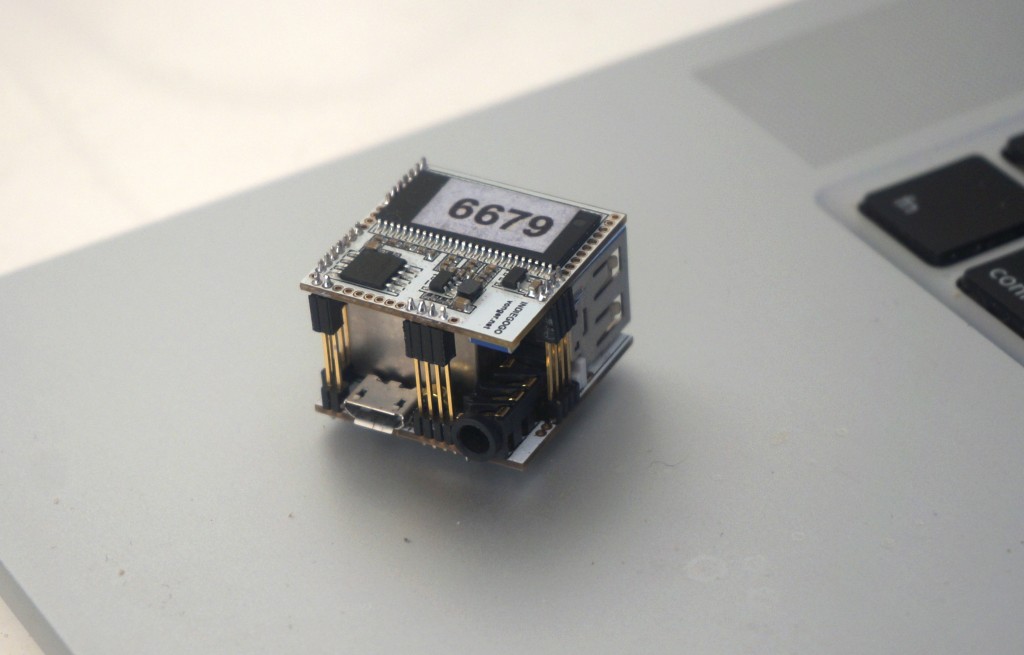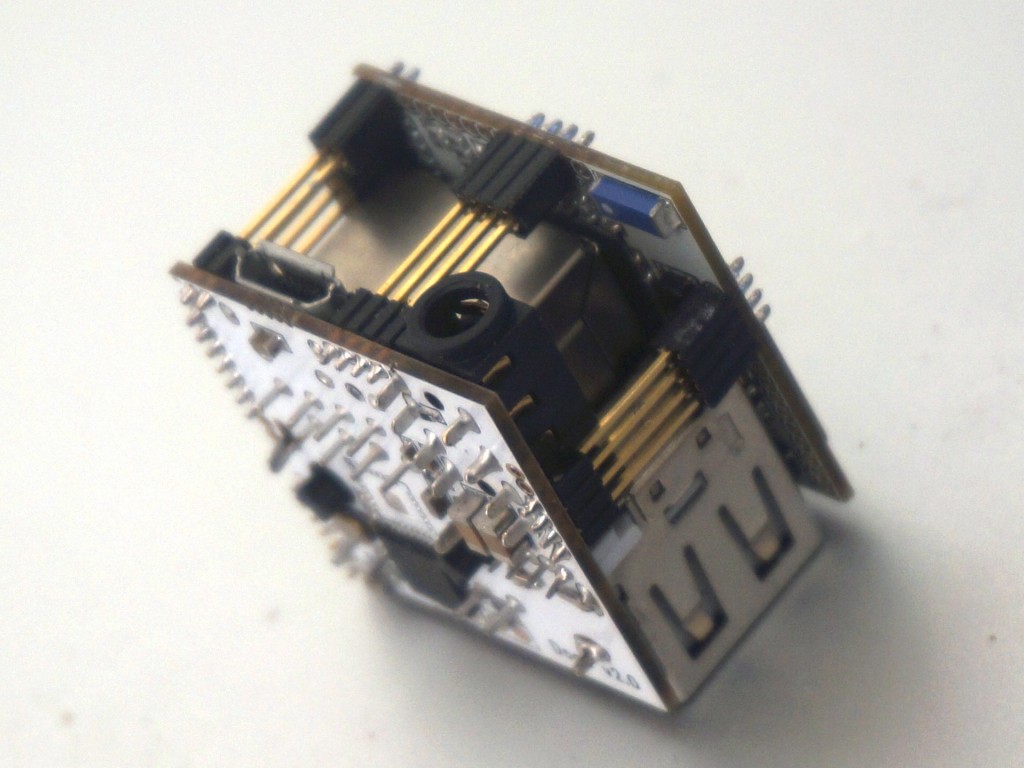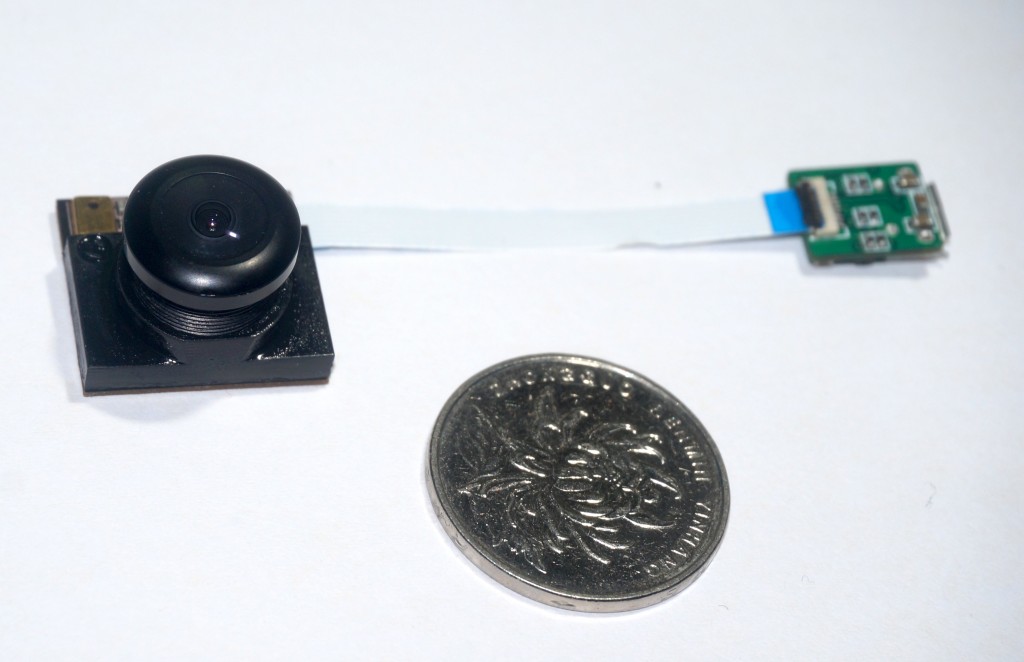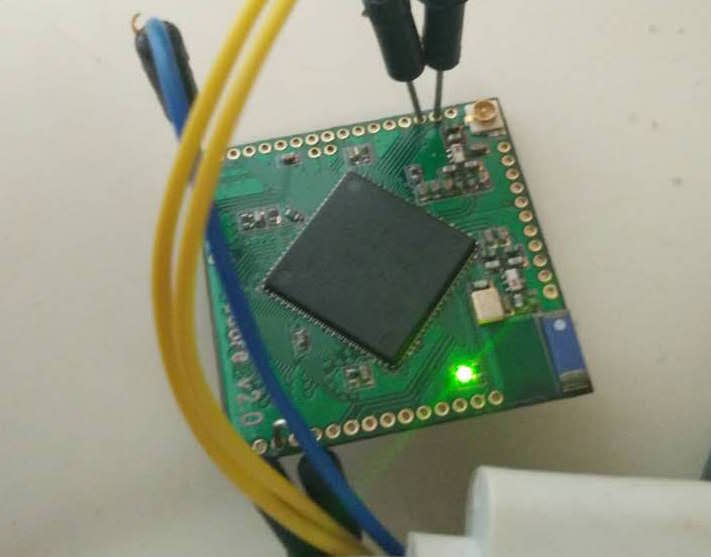[embedyt] http://www.youtube.com/watch?v=uWDr5UYh4o4[/embedyt]
PS: Sorry about first batch, the plastic dock is not matched very well, current batch fixed such problem. Please contact support@vocore.io to replace your plastic dock.
PSS: better to use 720p/15fps format or less for long time monitor usage(>= 30 minutes).
VoCore FHD H264 Camera Support
Firmware download here: Download
Source code for Linux here: uvc_3.10
Compile:
1. modify makefile
TARGET=sonix_uvcvideo
KDIR:=$YOUR_OPENWRT_PATH/build_dir/target-mipsel_24kec+dsp_uClibc-0.9.33.2/linux-ramips_rt305x/linux-3.10.49/
PWD:=$(shell pwd)
CCFLAGS += -I $(KDIR)/include/
$(TARGET)-objs := uvc_driver.o uvc_queue.o uvc_v4l2.o uvc_video.o uvc_ctrl.o \
uvc_status.o uvc_isight.o uvc_debugfs.o nalu.o
obj-m:=$(TARGET).o
default:
make $(CCFLAGS) -C $(KDIR) M=$(PWD) ARCH=mips CROSS_COMPILE=mipsel-openwrt-linux- modules
clean:
rm -rf *.o *.ko *.mod.* modules.* Module.* .tmp_versions .*.*.cmd
2. make it to create sonix_uvcvideo.ko
3. run on VoCore
opkg install kmod-input-core kmod-video-uvc insmod sonix_uvcvideo.ko
result:
/dev/video0 is mjpeg stream, /dev/video1 is h264 stream.
also you will find UAC, the 8K onboard microphone in /dev/ folder.
ls /dev/video*
v4l2-ctl --list-formats -d /dev/video0
v4l2-ctl --list-formats -d /dev/video1
opkg install v4l-utils
root@OpenWrt:~# v4l2-ctl --list-formats -d /dev/video0
ioctl: VIDIOC_ENUM_FMT
Index : 0
Type : Video Capture
Pixel Format: 'MJPG' (compressed)
Name : MJPEG
Index : 1
Type : Video Capture
Pixel Format: 'YUYV'
Name : YUV 4:2:2 (YUYV)
root@OpenWrt:~# v4l2-ctl --list-formats -d /dev/video1
ioctl: VIDIOC_ENUM_FMT
Index : 0
Type : Video Capture
Pixel Format: 'H264' (compressed)
Name : H.264
VoCore Dock2: Package Update
Recently I get some complain about the broken VoCore + Dock during the shipping especially the package to US.
The post office said currently there are too many packages already exceeds their limit, so it is normal some packages are broken…:'(
All new packages will ship with a plastic case, to avoid recently “violence delivery”.
And if your dock is broken during the shipping, please email to support@vocore.io with picture, we will ship a new replacement.
VoCore: Dock2 Firmware
This is the first version of the firmware
This firmware is only for dock2(with WM8960 chip at bottom)
Download at
http://vonger.cn/upload/firmware/vocore.dock2.bin
Compile by yourself:
1. clone openwrt 14.07 to your linux pc or vm.
git clone git://git.openwrt.org/14.07/openwrt.git
2. update VOCORE.dts, the following one is mine.
/dts-v1/;
/include/ "rt5350.dtsi"
/ {
compatible = "VoCore", "ralink,rt5350-soc";
model = "VoCore";
palmbus@10000000 {
gpio1: gpio@660 {
status = "okay";
};
spi@b00 {
status = "okay";
m25p80@0 {
#address-cells = <1>;
#size-cells = <1>;
compatible = "s25fl064k";
reg = <0>;
linux,modalias = "m25p80", "s25fl064k";
spi-max-frequency = <10000000>;
partition@0 {
label = "uboot";
reg = <0x0 0x30000>;
read-only;
};
partition@30000 {
label = "uboot-env";
reg = <0x30000 0x10000>;
read-only;
};
factory: partition@40000 {
label = "factory";
reg = <0x40000 0x10000>;
read-only;
};
partition@50000 {
label = "firmware";
reg = <0x50000 0xfb0000>;
};
};
spidev@1 {
compatible = "linux,spidev";
spi-max-frequency = <10000000>;
reg = <1>;
};
};
gdma: gdma@2800 {
compatible = "ralink,rt2880-gdma";
reg = <0x2800 0x800>;
resets = <&rstctrl 14>;
reset-names = "dma";
interrupt-parent = <&intc>;
interrupts = <7>;
#dma-cells = <1>;
#dma-channels = <16>;
#dma-requests = <8>;
};
i2s: i2s@a00 {
compatible = "ralink,mt7620a-i2s";
reg = <0xa00 0x100>;
resets = <&rstctrl 17>;
reset-names = "i2s";
interrupt-parent = <&intc>;
interrupts = <10>;
dmas = <&gdma 2 &gdma 3>;
dma-names = "tx", "rx";
};
};
pinctrl {
state_default: pinctrl0 {
gpio {
ralink,group = "jtag", "led";
ralink,function = "gpio";
};
gpio_i2s {
ralink,group = "uartf";
ralink,function = "gpio i2s";
};
};
};
ethernet@10100000 {
mtd-mac-address = <&factory 0x4>;
};
esw@10110000 {
ralink,portmap = <0x17>;
};
wmac@10180000 {
ralink,mtd-eeprom = <&factory 0>;
};
ehci@101c0000 {
status = "okay";
};
ohci@101c1000 {
status = "okay";
};
i2c-gpio {
compatible = "i2c-gpio";
gpios = <&gpio0 11 0 &gpio0 14 0>;
i2c-gpio,delay-us = <2>; /* around 400KHz */
#address-cells = <1>;
#size-cells = <0>;
wm8960: wm8960@1a {
compatible = "wm8960";
reg = <0x1a>;
};
};
audio {
compatible = "ralink,wm8960-audio";
model = "wm8960-audio";
cpu-dai = <&i2s>;
codec-dai = <&wm8960>;
};
gpio-export {
compatible = "gpio-export";
#size-cells = <0>;
gpio0 {
gpio-export,name = "gpio0";
gpio-export,direction_may_change = <1>;
gpios = <&gpio0 0 0>;
};
gpio12 {
/* UARTF_DCD_N */
gpio-export,name = "gpio12";
gpio-export,direction_may_change = <1>;
gpios = <&gpio0 12 0>;
};
gpio13 {
/* UARTF_DSR_N */
gpio-export,name = "gpio13";
gpio-export,direction_may_change = <1>;
gpios = <&gpio0 13 0>;
};
/* JTAG */
gpio17 {
/* JTAG_TDO */
gpio-export,name = "gpio17";
gpio-export,direction_may_change = <1>;
gpios = <&gpio0 17 0>;
};
gpio18 {
/* JTAG_TDI */
gpio-export,name = "gpio18";
gpio-export,direction_may_change = <1>;
gpios = <&gpio0 18 0>;
};
gpio19 {
/* JTAG_TMS */
gpio-export,name = "gpio19";
gpio-export,direction_may_change = <1>;
gpios = <&gpio0 19 0>;
};
gpio20 {
/* JTAG_TCLK */
gpio-export,name = "gpio20";
gpio-export,direction_may_change = <1>;
gpios = <&gpio0 20 0>;
};
gpio21 {
/* JTAG_TRST_N */
gpio-export,name = "gpio21";
gpio-export,direction_may_change = <1>;
gpios = <&gpio0 21 0>;
};
/* ETH LEDs */
gpio23 {
/* ETH1_LED */
gpio-export,name = "gpio23";
gpio-export,direction_may_change = <1>;
gpios = <&gpio1 1 0>;
};
gpio24 {
/* ETH2_LED */
gpio-export,name = "gpio24";
gpio-export,direction_may_change = <1>;
gpios = <&gpio1 2 0>;
};
gpio25 {
/* ETH3_LED */
gpio-export,name = "gpio25";
gpio-export,direction_may_change = <1>;
gpios = <&gpio1 3 0>;
};
};
gpio-leds {
compatible = "gpio-leds";
status {
label = "vocore:green:status";
gpios = <&gpio1 0 0>;
};
eth {
label = "vocore:orange:eth";
gpios = <&gpio1 4 0>;
};
};
};
3. Setup dma driver, add dma.mk to [openwrt]/package/kernel/linux/modules/
DMA_MENU:=DMA support
define KernelPackage/ralink-gdma
TITLE:=Ralink GDMA driver
SUBMENU:=$(DMA_MENU)
KCONFIG:= \
CONFIG_DMADEVICES=y \
CONFIG_DMA_ENGINE=y \
CONFIG_DMA_VIRTUAL_CHANNELS \
CONFIG_DMA_RALINK
FILES:= \
$(LINUX_DIR)/drivers/dma/virt-dma.ko \
$(LINUX_DIR)/drivers/dma/ralink-gdma.ko
AUTOLOAD:=$(call AutoLoad,11,ralink-gdma)
endef
define KernelPackage/ralink-gdma/description
Kernel module for Ralink GDMA device support
endef
$(eval $(call KernelPackage,ralink-gdma))
4. Setup ALSA DMA
Whatever I do to the makefile/config, still two files can not be compiled, no idea what is wrong.
They are $LINUX/sound/soc/soc-dmaengine-pcm.c soc-generic-dmaengine-pcm.c
I have to force them to be compiled.
4.1. modify $LINUX/sound/Kconfig, comment that ifneq and endif.
#ifneq ($(CONFIG_SND_SOC_DMAENGINE_PCM),) snd-soc-core-objs += soc-dmaengine-pcm.o #endif #ifneq ($(CONFIG_SND_SOC_GENERIC_DMAENGINE_PCM),) snd-soc-core-objs += soc-generic-dmaengine-pcm.o #endif
4.2. modify $OPENWRT/target/linux/ramips/rt305x/config-3.10 to force it compiled.
add two line at end of it.
CONFIG_SND_SOC_DMAENGINE_PCM=y CONFIG_SND_SOC_GENERIC_DMAENGINE_PCM=y
5. Setup ALSA WM8960/I2S driver.
modify $OPENWRT/target/linux/ramips/modules.mk
@TARGET_ramips_mt7620a to @TARGET_ramips, so it will show not only MT7620a kernel but also in RT5350.
define KernelPackage/sound-mt7620
TITLE:=MT7620 PCM/I2S Alsa Driver
DEPENDS:=@TARGET_ramips +kmod-sound-soc-core +kmod-regmap
KCONFIG:= \
CONFIG_SND_MT7620_SOC_I2S \
CONFIG_SND_MT7620_SOC_WM8960
FILES:= \
$(LINUX_DIR)/sound/soc/ralink/snd-soc-mt7620-i2s.ko \
$(LINUX_DIR)/sound/soc/ralink/snd-soc-mt7620-wm8960.ko \
$(LINUX_DIR)/sound/soc/codecs/snd-soc-wm8960.ko
AUTOLOAD:=$(call AutoLoad,90,snd-soc-wm8960 snd-soc-mt7620-i2s snd-soc-mt7620-wm8960)
$(call AddDepends/sound)
endef
define KernelPackage/sound-mt7620/description
Alsa modules for ralink i2s controller.
endef
$(eval $(call KernelPackage,sound-mt7620))
6. Now, everything is ready. make menuconfig
Select in Kernel modules:
add I2C support/kmod-i2c-gpio-custom;
del I2C support/kmod-i2c-ralink;
add DMA support/kmod-ralink-gdma
add Sound support/kmod-sound-mt7620
7. That’s all, make V=s, build the bin file.
Later I will do more test on this firmware, dma, i2c and i2s works well in this firmware.
Drivers works:
root@OpenWrt:/dev# ls
audio i2c-0 mtd0ro mtd3ro mtdblock1 network_throughput shm urandom
bus kmsg mtd1 mtd4 mtdblock2 null snd watchdog
console log mtd1ro mtd4ro mtdblock3 ppp spidev32766.1 watchdog0
cpu_dma_latency mem mtd2 mtd5 mtdblock4 ptmx tty zero
dsp mixer mtd2ro mtd5ro mtdblock5 pts ttyS0
full mtd0 mtd3 mtdblock0 network_latency random ttyS1
root@OpenWrt:/dev# cd snd
root@OpenWrt:/dev/snd# ls
controlC0 pcmC0D0c pcmC0D0p timer
root@OpenWrt:/dev/snd# lsmod
arc4 1312 2
cfg80211 197639 2 rt2x00lib
compat 2285 3 rt2800soc
crc_ccitt 1019 2 rt2800lib
crc_itu_t 1019 0
crypto_blkcipher 10375 1 arc4
eeprom_93cx6 1807 0
ehci_hcd 29964 1 ehci_platform
ehci_platform 2272 0
gpio_button_hotplug 5984 0
i2c_algo_bit 4538 1 i2c_gpio
i2c_core 15054 6 snd_soc_wm8960
i2c_dev 4064 0
i2c_gpio 2400 0
input_core 24281 1 snd
ip6_tables 8993 3 ip6table_raw
ip6t_REJECT 2336 2
ip6table_filter 608 1
ip6table_mangle 1024 1
ip6table_raw 576 1
ip_tables 9165 4 iptable_nat
ipt_MASQUERADE 1136 1
ipt_REJECT 1776 2
iptable_filter 672 1
iptable_mangle 928 1
iptable_nat 1680 1
iptable_raw 640 1
ipv6 238854 26 ip6t_REJECT
leds_gpio 2944 0
lzo_compress 2082 1 regmap_core
lzo_decompress 1351 1 regmap_core
mac80211 344225 3 rt2800lib
nf_conntrack 44715 13 iptable_nat
nf_conntrack_ftp 5136 1 nf_nat_ftp
nf_conntrack_ipv4 4676 8
nf_conntrack_ipv6 4976 3
nf_conntrack_irc 2784 1 nf_nat_irc
nf_defrag_ipv4 758 1 nf_conntrack_ipv4
nf_defrag_ipv6 8695 1 nf_conntrack_ipv6
nf_nat 9759 7 iptable_nat
nf_nat_ftp 1216 0
nf_nat_ipv4 2526 1 iptable_nat
nf_nat_irc 1008 0
nls_base 5006 1 usbcore
of_i2c 1344 1 i2c_gpio
ohci_hcd 13360 0
ppp_async 6176 0
ppp_generic 19650 3 pppoe
pppoe 7744 0
pppox 1338 1 pppoe
ralink_gdma 4032 2
regmap_core 25039 4 snd_soc_wm8960
regmap_i2c 966 2 snd_soc_wm8960
regmap_spi 1078 1 snd_soc_core
rt2800lib 91441 2 rt2800soc
rt2800mmio 6338 1 rt2800soc
rt2800soc 2464 0
rt2x00lib 34047 5 rt2800soc
rt2x00mmio 1952 2 rt2800soc
rt2x00soc 1218 1 rt2800soc
slhc 4347 1 ppp_generic
snd 39083 10 snd_soc_wm8960
snd_compress 6175 1 snd_soc_core
snd_hwdep 4302 0
snd_mixer_oss 12393 1 snd_pcm_oss
snd_page_alloc 3249 1 snd_pcm
snd_pcm 56509 2 snd_soc_core
snd_pcm_oss 33553 0
snd_rawmidi 14995 0
snd_seq_device 4301 1 snd_rawmidi
snd_soc_core 91031 3 snd_soc_mt7620_wm8960
snd_soc_mt7620_i2s 2896 2
snd_soc_mt7620_wm8960 2048 0
snd_soc_wm8960 16944 1
snd_timer 14382 1 snd_pcm
soundcore 3788 1 snd
usb_common 1160 1 usbcore
usbcore 106727 3 ohci_hcd
virt_dma 1333 1 ralink_gdma
x_tables 10997 26 ipt_MASQUERADE
xt_CT 2272 0
xt_LOG 9552 0
xt_REDIRECT 1056 0
xt_TCPMSS 2704 2
xt_comment 480 53
xt_conntrack 2144 10
xt_id 480 0
xt_limit 992 20
xt_mac 608 0
xt_mark 672 0
xt_multiport 1200 0
xt_nat 1072 0
xt_state 688 0
xt_tcpudp 1712 8
xt_time 1664 0
root@OpenWrt:/sys/class/dma# ls
dma0chan0 dma0chan1 dma0chan10 dma0chan11 dma0chan12 dma0chan13 dma0chan14 dma0chan15 dma0chan2 dma0chan3 dma0chan4 dma0chan5 dma0chan6 dma0chan7 dma0chan8 dma0chan9
root@OpenWrt:/proc# cat interrupts
CPU0
5: 203 MIPS 10100000.ethernet
6: 229856 MIPS rt2800_wmac
7: 353640 MIPS timer
9: 0 INTC 10000100.timer
15: 121 INTC 10002800.gdma
20: 30 INTC serial
25: 1 INTC esw
26: 1 INTC ehci_hcd:usb1, ohci_hcd:usb2
ERR: 0
ralink-gdma.c might have a bug, once I remove the log output, it will not trigger 10002800.gdma interrupts, very weird.
VoCore: Audio Driver
Special thanks to Guangqian Luo. When I am debugging my linux audio driver, he notified me there already exists source code in linux kernel/ALSA and it really works. He is using the right way doing the work but I am not 😀 I am reinventing the wheel…ALSA exists code is much better than mine.
To make WM8960 work, we need five necessary parts:
1. I2C interface, used to transfer command to WM8960.
2. I2S interface, used to transfer data to WM8960.
3. WM8960 driver, used to call I2S, I2C driver.
4. ALSA middle layer driver, used to connect user and kernel.
5. DMA interface, used to smooth data transfer between software and hardware.
1. I2C part, that is easy, we use i2c-gpio, based on gpio 11,14.
add these lines to VOCORE.dts, root part.
i2c-gpio {
compatible = "i2c-gpio";
gpios = <&gpio0 11 0 &gpio0 14 0>;
i2c-gpio,delay-us = <2>; /* around 400KHz */
#address-cells = <1>;
#size-cells = <0>;
wm8960: wm8960@1a {
compatible = "wm8960";
reg = <0x1a>;
};
};
2. I2S interface, source code already there, in [kernel]/sound/soc/ralink/mt7620-i2s.c
This is for MT7620, but I checked datasheet, the register of MT7620 and RT5350 are 99% same, only one bit is not same but nothing matter.
3. WM8960 driver.
[kernel]/sound/soc/codecs/wm8960.c
4. ALSA driver.
[kernel]/sound/soc/ralink/mt7620-wm8960.c
5. DMA driver.
[kernel]/drivers/dma/ralink-gdma.c
Haha, the codes are clean and stable(OpenWRT 14.07, Linux 3.10.49), looks like my code is useless now, maybe later it can be used to help starter learn kernel driver.
I will base on the exists source make a new firmware soon.
New Dock with Audio Codec for VoCore
VoCore + Dock has updated, now audio codec is on it, new buyers’ docks(>= Oct.14) are updated to the new one already.
New docks are able to play music, also record sound remotely by its on board microphone.
New features for hardware and software:
1. audio codec WM8960G for record and playback(I2S interface to VoCore).
2. microphone, headphone slot.
3. on board 4mm microphone.
4. lower its power consume from 1.0watt to 0.5watt.
5. fix ap+sta mode.(using helper program: vocoremon, stable version)
Hope you enjoy the new features and have new adventure. 🙂
New dock firmware download here: http://vonger.cn/upload/firmware/vocore.dock2.bin
PS:
1. New docks are very hard to production even in the most experience factory…the process is slow, have to add two weeks lead time(maybe more).
2. This time, we will make some separated docks, so old VoCore+Docks are also able to update. It will be shown in store once we have enough in stock. Discount $5 for old dock owners and also free shipping.
3. Driver is still under develop(planed to be released this week, but have to deal the production first :'( ), once it is done, will commit to openwrt.org, also release firmware on the blog/forum/facebook, sorry for the delay.
VoCam264: Perfect now!
After 12 failed versions, finally I made it.
Pure Video Quality: every detail, just that clean.
Low Power Consumption: h264 mode <= 0.75w(1080p/25fps); MJPG <= 0.7w
Small size: 20mm only.
High Compress: 1080p/25fps, 300~600KB/s
Embed Microphone: 8KHz, sound record.
USB 2.0 Interface: directly connect to VoCore or PC, no driver requested(mjpeg).
Lens: 2.8mm 130°
Stable Temperature: -10~35℃ (1080p/15fps, 0.75watt)
Max Operation Temperature: 45℃
Max: 1080p, 30fps(this is not good for CMOS, might cause permanently damage)
WARNING: over 45℃ might cause permanently damage to CMOS, suggest use it in room under 35C(heat sink is necessary).
I spend over 1000 hours on this little thing, once I even think it is impossible: I can not avoid noise from DCDC effects the video quality; I can not lower the power consumption; I can not reduce the heat; I can not… but everything has passed, THERE IT IS.
This is a real challenge. 😀 What next?
PS: we did not compose the heat sink and lens.
Fix VoCore can not show AP when STA not working in AP+STA
Recently I am trying to fix a issue that most people had already known it: if you setting up VoCore into AP+STA mode to connect to your home router(or any router else), once your changed your home router password or you bring VoCore to another place that it can not find your home router AP signal ,VoCore will failed to create its “VoCore-XXXXXX” AP hot point.
(Is Chinglish the most popular language on internet? 😀 Hope you can understand what I am saying upper)
The problem is you will not able to connect to VoCore through wireless if you bring your VoCore-in-AP+STA-mode to another place.
Last time I introduce a script writing by LiZhuohuan, but it has some limit, it is not clever enough, it only change your VoCore from AP+STA to AP when it detect VoCore can not connect to your home router, but once your VoCore back to your home, it can not recover it, you have to set AP+STA back manually, and the script keep running every 10~30 seconds, that takes power. So I write this little tool do all magically.
Install:
Copy vocoremon to /bin/vocoremon
Add one line into /etc/rc.local:
/bin/vocoremon 20 >> /tmp/vocore.log &
That’s ALL.
Every time VoCore boot up, it will run vocoremon, if AP+STA is normal, quit itself, else vocoremon makes VoCore run in AP mode. When next time boot, vocoremon find your STA back to normal, it will quit AP mode and make VoCore run back into AP+STA mode.
So once you install vocoremon, do not have to take USB2TTL anymore, VoCore are able to create its AP hot point anywhere, any setting.
I tested it, works normal in my home, but I know the situation is complex, it has a low chance not working, I open the source code into https://github.com/Vonger/vocoremon.git, hope everybody could update it make it better.
The bin file can be download here. http://vonger.cn/upload/tools/vocoremon
VoCore: Power Save Test => Turn off WIFI + Ethernet
Just want to know, in standby mode, how much power will VoCore consume.
It is very interesting, if we shutdown ethernet, VoCore current consume will low to 0.1A(0.5watt), if we shut down wifi, how much power will it consume?
First, call script http://vonger.cn/?p=1880, shutdown the ethernet.
Then, power off wifi.(add “option disabled 1” to /etc/config/wireless)
The result of RT5350 is really out of my imagination.
Here is the picture and the truth:
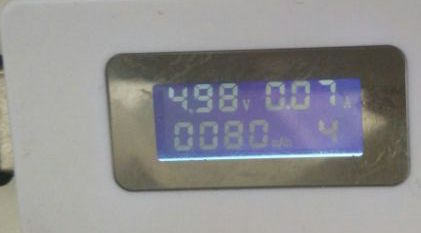
1h20m, but only 80mAh!(Three hours is around 200mAh)
That means it consumes ONLY 70mAh every hour, a small Li-battery(2000mAh) will able to make it work over a day!
VoCore is not sleeping, we can enable the wifi or ethernet anytime in 3 seconds through UART.
Same test for VoCore2: standby power consume is around 63mAh…Emm, this result is not much better, but fair, 580MHz vs 360MHz. Looks like it is the chip limit.
